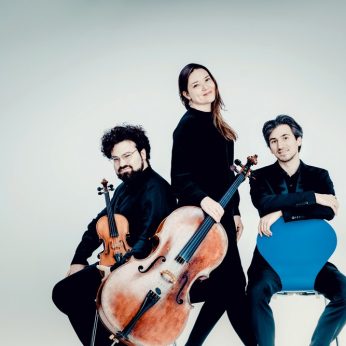Composer: Joseph Haydn (b. 1732 - d. 1809)
Performance date: 28/06/2023
Venue: Bantry House
Composition Year: 1795
Duration: 00:13:45
Recording Engineer: Tom Norton, RTÉ
Instrumentation: vn, vc, pf
Instrumentation Category:Piano Trio
Artists:
Trio Gaspard (Jonian Kadesha [violin], Vashti Hunter [cello], Nicholas Rimmer [piano]) -
[Piano Trio]

Piano Trio No.40 Op.73 No.3 in F sharp minor Hob XV.26 [1795]
Allegro
Adagio
Tempo di Minuet – Adagio – Tempo 1 – Coda
Haydn is truly a master at opening ideas and this trio is no different – his first bars draw the listener in instantly. The thematic drama develops as the piece goes on. In some ways it extraordinary that with the simplest building blocks in rhythm and melody, Haydn creates such a depth of sound and musical expression. Haydn keeps our attention, and maintains the drama by moving between keys. This is a curious movement, showing both the typically elegant and melodious Haydn, while creating something more sombre and enigmatic. Compositional precision of the interplay between instruments is a demonstration of his mastery of musical dialogue, not only between instruments, but between musical ideas. The strings do far more than simply ‘accompany’ the piano, as is often assumed for his piano trios. The final phrases in this movement are dramatic and full of motion and life.
The Adagio is tantalising and romantic, almost languorous in its mood. The movement shows the maturity of Haydn’s compositions at this time. He had travelled twice to London and the positive reception, as well as the vibrant music scene there, particularly the works of Handel, gave an added depth to his compositions in the 1790s. This movement sounds very modern for its time – the use of rests, of silence, and the delicacy of the melodies, are almost Romantic and the sweeping bow work in the strings adds to this sense.
Simplicity in the minuet, is a backdrop to the elegant ornamentation in the piano part. The dotted rhythm in the strings maintains the dance-like form, although this minuet has none of the frivolity that we might associate with dance, the overall mood being one of dignity and elegance. There is something very Viennese about this movement – stately, ornamented and lyrical. Haydn had returned to Vienna after his second visit to London and spent his last years there. The movement between registers and keys keeps the listener guessing, never quite sure of what atmosphere will come next.
Helen Dawson
Copyright © 2025 West Cork Music. All rights reserved.
Designed and developed by Matrix Internet